
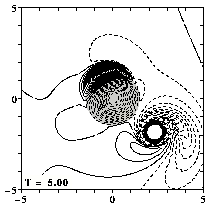

The simulation discussed on the pabe Bessel monopole encounters a circular mountain is with f0=0 in the Coriolis paramter. This means that the ridge is located at the equator. For non-zero f0-values, the monopole's evolution can be quite different, depending on the f0-value.
Consider the same initial situation as on Bessel monopole encounters a circular mountain but now with f0=+3, which means that the ridge is on the northern hemisphere.
For all graphs: positive contours (0.1 to 2.0 at an interval of 0.1) are drawn solid, negative contours (-0.1 to -2.0 at an interval of -0.1) are drawn dashed, and the zero contour is dotted. Since the maximum of vorticity at the centre of the monopole is much larger than 2.0, the vortex looks like a "hole".
Note that the domain measures 20 by 20 length units -- the graphs show only the central part of this domain.
Turning on the time evolution means that the monopole moves to the north-west, due to the beta-effect.
The motion of the monopole and its rotation about its centre results in a flow across the mountain, similar to the case of a uniform flow across a mountain, and relative vorticity is generated. Since f0 is positive, the fluid moving away from the mountain gets positive relative vorticity and the fluid moving onto the mountain gets negative relative vorticity.
The monopole reaches the mountain, surrounded by a "ring" of negative vorticity (a result of the Rossby waves it leaves behind as it moves due to the beta-effect). The mountain is "covered" in negative vorticity and the monopole is "caugth" in this and can climb the mountain somewhat:
On a sloping bottom, a positive monopole tends to the go to the local northwest (a sloping bottom is dynamically equivalent to the beta-effect). Which means that the monopole will try to spiral towards the top of the mountain. Combining this motion with the motion of the fluid induced by the negative vorticity generated at the mountain, appears to make the monopole circle around the top of the mountain:
The monopole continues to circle around the mountain, with being able to leave the mountain. In this process the monopole is deformed by the vorticity beside and on the mountain. The monopole is able to restore its form several times, until it has become too weak (shortly after T=80) and it is torn apart.
A movie shows far more clearly the effect of the mountain on the monopole. There are two movies of this simulation:
===> MPEG movie (0.5 Mb; 101 frames) -- from T=0 until T=50.
===> MPEG movie (1.1 Mb; 201 frames) -- from T=0 until T=100.
The monopole's motion across the mountain and its maximum of vorticity are shown in these graphs:
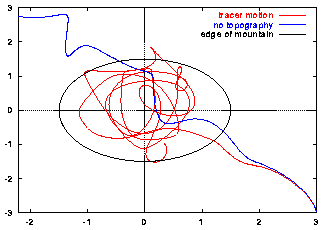
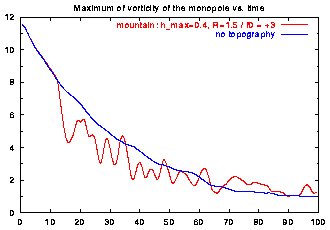
The left graph above shows a tangle of lines with is not really clear. Plotting time as a third dimension shows clearer what the motion of the monopole is:

The motion of the tracer (solid black line), with time plotted vertically;
dots are placed avery 2.5 time units.
The dashed circles indicate the edge of the mountain (drawn at T=0, 50
and 100).
This mountain, in combination with f0=+3, evidently traps the monopole on the mountain.
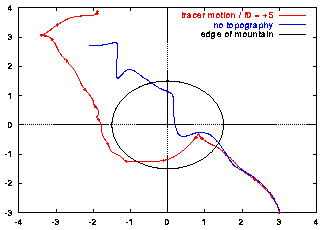
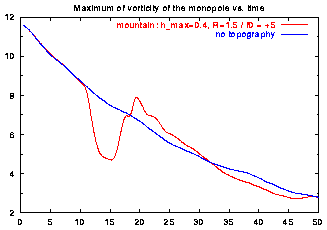
For negative f0-values, i.e. a mountain on the
southern hemisphere, things are quite different.
===> Bessel monopole encounters a circular
mountain -- with f0=-3.
<=== Bessel monopole encounters a circular mountain -- with f0=0.
The evolution of the vorticity distribution is computed with a Finite Difference Method which solves the two-dimensional vorticity (Navier-Stokes) equation. Time and distances are given in dimensionless units.
===> Some details on the computation presented on this page for those who are interested.
<=== Numerical simulations of 2D vortex evolution with a Finite Difference Method.
 Jos van Geffen --
Home |
Site Map |
Contact Me
Jos van Geffen --
Home |
Site Map |
Contact Me